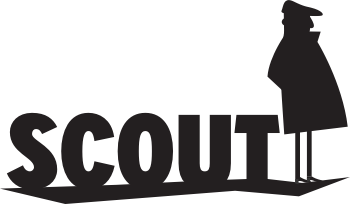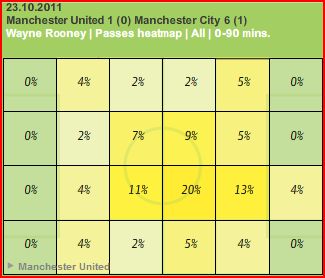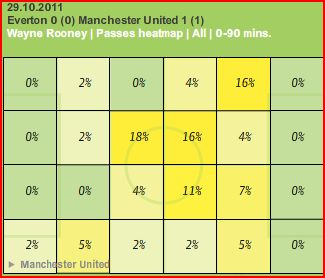The 6-1 home hammering at the hands of Man City has clearly had an effect. Humbled in front of their own fans, with Sir Alex Ferguson describing it as the “worst result in my history”, United’s line-up for last weekend’s trip to Goodison raised more than a few eyebrows.
The role assigned to Wayne Rooney will have many a Fantasy manager fretting. With Fergie seeking extra solidity, Rooney dropped into central midfield, allowing Javier Hernandez to lead the line as the lone frontman but, ahead of a favourable run of fixtures, it’s the last thing his Fantasy owners want to contemplate. Tonight’s Champions League line-up against Otelul Galati will only further deepen the concern, with Rooney once again selected in the United midfield, with Michael Owen and Dimitar Berbatov leading the line. We take a look at Rooney’s last two league games to see just how they differ:
Average Position

A look at Rooney’s average position in the City game (above) shows Rooney’s (10) tendency to drop deep, even when United play 4-4-2. With City so much in control, though, Danny Welbeck (19) was also deep- both Ashley Young (18) and Nani (17) stayed high and wide and with a far from compact shape, United were torn apart by their clinical opponents.
The Everton match (above) shows Rooney was, on average, in an almost identical position when in possession, despite his new midfield role. The main difference, though, is how this compares in relation to the team mates around him. There is no width, no players further forward- Hernandez (14) dropped deep when on the ball and is obscured by Rooney (10) here. United’s defence-minded outlook offered little ahead of Rooney for him to make any significant attacking contribution.
Passing
Against City, Rooney made a total of 57 passes. A look at the chalkboard again shows how he came deep to link with the midfield, with 47% of all passes coming in the middle of the central third of the pitch. Remarkably, this is almost identical to the Everton match; here, Rooney also makes 57 passes, with 49% coming in the same area.
It’s when you look at the other areas of the field that the difference is more substantial; against City, for example, 28% of Rooney’s passes were from positions on the flank. With Young and Nani providing plenty width, he had far less a tendency to move from the centre in comparison to his display at Goodison- 38% of his distribution came from the wings against David Moyes’ side as he sought space in order to make an impact.
The most significant area for Rooney, though, the centre of the final third, shows a definite decrease in attacking potential over the two games. Against City, 22% (13% + 4% + 5%) of Rooney’s passes came in this vital area as he prompted and probed, looking for openings- against Everton, Rooney’s impact in this crucial part of the field halved, down to 11% (7% +4%). With Fergie reining in his star forward’s attacking sensibilities, their potency clearly diminished.
A look at United’s preferred passing in each game is also instructive. Against City, Rooney received 15 passes from Welbeck- the most balls from any team mate- and played 6 passes to his fellow-forward- a total of 21 passes between the United frontmen.
In the Goodison game, though, it was a different matter; Rooney received more passes (7) from Jonny Evans than any other United player, with Phil Jones and Patrice Evra next best on 6; an indication of how deep he dropped to gain possession at times. Ahead of him, Rooney barely linked up with Hernandez at all; he played just 2 successful passes to the Mexican, receiving 3 in return. Compare that to the interplay with Welbeck against City, and there’s a definite drop in attacking intent.
Match Stats
Post-match, Fergie explained the thinking behind his decision to move Rooney back:
It’s about time we won 1-0. That was the aspect of the game that pleased me most, that and restricting Everton to very few chances. We had to do something about the fact that opponents have been getting too many opportunities to score against us in recent weeks. We knew we had to reduce that number if we are going to win the league, and reinforcing the midfield was one way of doing it. We brought Wayne back to increase our numbers in midfield.
Perhaps a look at the statistics will make the United boss think twice, though. In no way did his side restrict Everton’s chances: over the season so far, they have averaged 19 shots against per game- on Saturday, Everton fired in 19 goal attempts again. If anything, his tactics only had a detrimental effect on his own side’s endeavors going forward- United have averaged 16 shots per game so far this season, whereas at Goodison last weekend, they mustered 7 all game.
Indeed, David De Gea saved more shots (8) than United managed over the entire ninety minutes. From a central midfield position, Rooney had just 1 shot against his old club- not what you’d want from a 12.2 Fantasy prospect, particularly with the likes of Robin Van Persie tearing up the top-flight right now.
Clearly, Fergie holds no fears of utilising Rooney in a different role if he feels it’s beneficial to the team as a whole- a spell out wide a couple of seasons back proves testament to that. The uncertainty has clearly had an effect- so far, Rooney has been sold on by 72,000 Fantasy managers this week, despite a home clash with Sunderland up next. Tonight’s performance will give his 41% of Fantasy owners plenty to mull over- another game from deep without any attacking rewards could cause many to rethink over the forthcoming international break.





13 years, 11 days agoLast nights champions league has thrown my wildcard plans next week into dissarry 🙂 Silva injury and Roooney playingin midfield. Might have a play about with my team and go for Hernandez Aguero and VP up top see how I can adapt my squad.